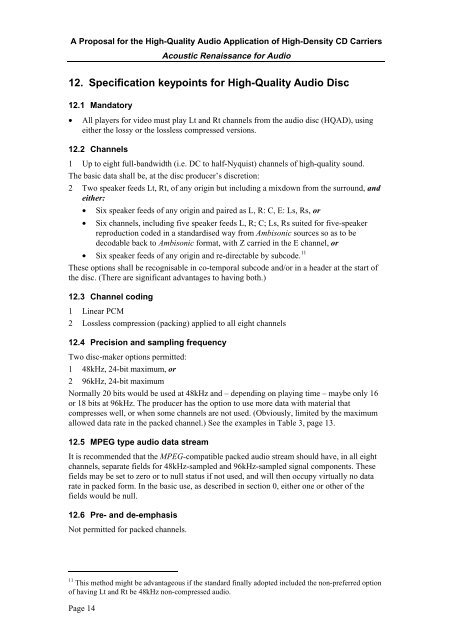A Proposal for the High-Quality Audio Application of High ... - Meridian
A Proposal for the High-Quality Audio Application of High ... - Meridian
A Proposal for the High-Quality Audio Application of High ... - Meridian
You also want an ePaper? Increase the reach of your titles
YUMPU automatically turns print PDFs into web optimized ePapers that Google loves.
A <strong>Proposal</strong> <strong>for</strong> <strong>the</strong> <strong>High</strong>-<strong>Quality</strong> <strong>Audio</strong> <strong>Application</strong> <strong>of</strong> <strong>High</strong>-Density CD Carriers<br />
Page 14<br />
Acoustic Renaissance <strong>for</strong> <strong>Audio</strong><br />
12. Specification keypoints <strong>for</strong> <strong>High</strong>-<strong>Quality</strong> <strong>Audio</strong> Disc<br />
12.1 Mandatory<br />
• All players <strong>for</strong> video must play Lt and Rt channels from <strong>the</strong> audio disc (HQAD), using<br />
ei<strong>the</strong>r <strong>the</strong> lossy or <strong>the</strong> lossless compressed versions.<br />
12.2 Channels<br />
1 Up to eight full-bandwidth (i.e. DC to half-Nyquist) channels <strong>of</strong> high-quality sound.<br />
The basic data shall be, at <strong>the</strong> disc producer’s discretion:<br />
2 Two speaker feeds Lt, Rt, <strong>of</strong> any origin but including a mixdown from <strong>the</strong> surround, and<br />
ei<strong>the</strong>r:<br />
• Six speaker feeds <strong>of</strong> any origin and paired as L, R: C, E: Ls, Rs, or<br />
• Six channels, including five speaker feeds L, R; C; Ls, Rs suited <strong>for</strong> five-speaker<br />
reproduction coded in a standardised way from Ambisonic sources so as to be<br />
decodable back to Ambisonic <strong>for</strong>mat, with Z carried in <strong>the</strong> E channel, or<br />
• Six speaker feeds <strong>of</strong> any origin and re-directable by subcode. 11<br />
These options shall be recognisable in co-temporal subcode and/or in a header at <strong>the</strong> start <strong>of</strong><br />
<strong>the</strong> disc. (There are significant advantages to having both.)<br />
12.3 Channel coding<br />
1 Linear PCM<br />
2 Lossless compression (packing) applied to all eight channels<br />
12.4 Precision and sampling frequency<br />
Two disc-maker options permitted:<br />
1 48kHz, 24-bit maximum, or<br />
2 96kHz, 24-bit maximum<br />
Normally 20 bits would be used at 48kHz and – depending on playing time – maybe only 16<br />
or 18 bits at 96kHz. The producer has <strong>the</strong> option to use more data with material that<br />
compresses well, or when some channels are not used. (Obviously, limited by <strong>the</strong> maximum<br />
allowed data rate in <strong>the</strong> packed channel.) See <strong>the</strong> examples in Table 3, page 13.<br />
12.5 MPEG type audio data stream<br />
It is recommended that <strong>the</strong> MPEG-compatible packed audio stream should have, in all eight<br />
channels, separate fields <strong>for</strong> 48kHz-sampled and 96kHz-sampled signal components. These<br />
fields may be set to zero or to null status if not used, and will <strong>the</strong>n occupy virtually no data<br />
rate in packed <strong>for</strong>m. In <strong>the</strong> basic use, as described in section 0, ei<strong>the</strong>r one or o<strong>the</strong>r <strong>of</strong> <strong>the</strong><br />
fields would be null.<br />
12.6 Pre- and de-emphasis<br />
Not permitted <strong>for</strong> packed channels.<br />
11 This method might be advantageous if <strong>the</strong> standard finally adopted included <strong>the</strong> non-preferred option<br />
<strong>of</strong> having Lt and Rt be 48kHz non-compressed audio.


